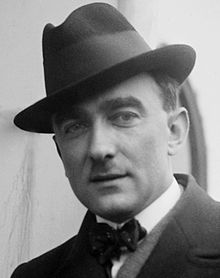music.wikisort.org - Composition
Karol Szymanowski's Piano Sonata No. 2 in A major, Op. 21, M25, is a piano sonata in two movements. It was completed in 1911 and published in 1912 by Universal Edition Vienna. The sonata is still a relatively early work of Szymanowski, but represents the start of his more experimental and atonal period. It was premiered by Arthur Rubinstein on 7 May 1911.[1][2]
Historical background
The work was completed in 1911 in Tymoszówka, when Szymanowski was 29 years old, not long after completing his Second Symphony.
Shortly after its completion, Szymanowski wrote in a letter to Polish friend and music historian Zdzisław Jachimecki:
"I have just finished the second 'Piano Sonata' before Arthur arrived. At first I did not attach a great importance to it, yet after a detailed study and after Arthur having played it all the 'hidden virtues' have come to light and as a result Ficio and Arthur got immensely excited about it, almost considering it superior to the Symphony."[3]
Analysis
The sonata comprises two movements:
- Allegro assai (Molto appassionato) (A minor – D♭ major – A minor – A major)
- Theme and variations (A major – F major – B♭ major – A major – E major – A major)
1. Allegro assai (Molto appassionato)

8 - 10 minutes
The first movement starts in cut time. It opens with a dark, chaotic and almost atonal introductory theme, which is referred to at various stages throughout the two movements, of broken octaves descending chromatically in tuplets in the left hand, aided by a simple melody of ascending octaves in the right. The theme progresses and changes time signatures numerous times until the start of the Quasi andante section.
At the start of the Quasi andante section, the key changes to D♭ major and 2/4 time, and a new, more lyrical theme emerges.
2. Theme and variations
17 - 19 minutes
The second movement comprises a theme, eight variations, and a fugue.
Reception
After a performance of the sonata at a concert devoted to Szymanowski's works in December 1911, Willy Renz wrote in the magazine Die Musik:
“If the composer forces himself towards greater transparency, to a sensible limit and concentration, if he can restrain his excessive fondness for contrapuntal tricks, polyphonic complications and orchestral excesses, we will have high hopes of him”[4]
After attending a 1912 performance of the sonata by Arthur Rubinstein in Berlin, feeling that he could never reach Rubinstein's level as a pianist nor Szymanowski's level as a composer, Heinrich Neuhaus attempted suicide. After the incident, Szymanowski and Rubinstein found him safe and recovering in a hospital in Florence.[5]
The sonata has developed a reputation of an extremely hard piece to master, both musically and technically, and after the Second World War it found its way into the repertoire of pianists such as Sviatoslav Richter or Marc-André Hamelin.[citation needed]
References
- "Piano Sonata No. 2 A major op. 21 (1910-1911) | Karol Szymanowski". www.karolszymanowski.pl. Retrieved 7 August 2018.
- "Piano Sonata No. 2 in A major Op. 21 – Karol Szymanowski". Culture.pl. Retrieved 12 August 2018.
- "Piano Sonata No. 2 in a major Op. 21 – Karol Szymanowski".
- "Piano Sonata No. 2 A major op. 21 (1910-1911) | Karol Szymanowski". www.karolszymanowski.pl. Retrieved 7 August 2018.
- Rubinstein, Arthur (1973). My Young Years (1st ed.). New York: Knopf. pp. 372. ISBN 0394468902. OCLC 520585.
Другой контент может иметь иную лицензию. Перед использованием материалов сайта WikiSort.org внимательно изучите правила лицензирования конкретных элементов наполнения сайта.
WikiSort.org - проект по пересортировке и дополнению контента Википедии
